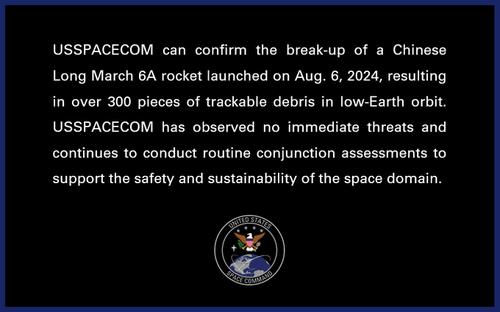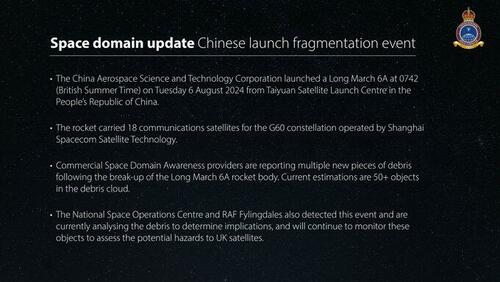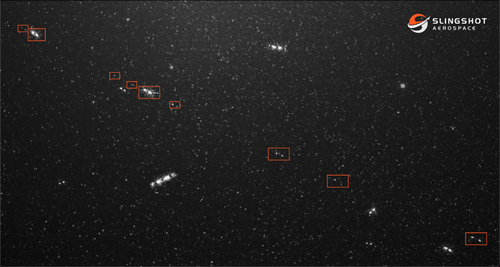
The Chinese Long March 6A rocket, launched from the Taiyuan Satellite Launch Center in north China on Tuesday, carrying 18 Qianfan ("Thousand Sails") satellites to low Earth orbit (LEO), has broken up in space.
On Thursday afternoon, US Space Command announced on X that the "Long March 6A rocket launched on Aug. 6, 2024" has broken up in LEO, "resulting in over 300 pieces of trackable debris in low-Earth orbit."
Space Command has "observed no immediate threats and continues to conduct routine conjunction assessments to support the safety and sustainability of the space domain."
Earlier, UK Space Command wrote on X that "the break-up of the Long March 6A rocket body" has created a "debris cloud" in LEO and is still analyzing the situation to "determine implications" for satellite constellations operating in LEO.
Space News said the Qianfan satellites are part of a new "planned mega constellation of more than 14,000 low Earth orbit (LEO) communications satellites," adding, "the mission appears to have created a string of debris along its orbital path."
Slingshot Aerospace, a space-tracking and data analytics firm, published data on the debris cloud on X, indicating the "space debris that poses a significant hazard to LEO constellations below 800 km altitude."
🚨 Slingshot Orbital Alert 🚨
— Slingshot Aerospace (@sling_shot_aero) August 7, 2024
Following China's launch of 18 G60 satellites on August 6th, Slingshot is tracking over 50 pieces of space debris that pose a significant hazard to LEO constellations below 800 km altitude. pic.twitter.com/Etmui8X5Po
Swiss firm S2a Systems posted some of the first images of the debris cloud.
Our first visual observations of some of the CZ-6A upper stage debris from the launch of the 18 G60 satellites. It is a widely scattered debris field. Many thanks for publishing orbital data to @sling_shot_aero. @shell_jim pic.twitter.com/x3xPfp1Zu3
— s2a systems (@s2a_systems) August 8, 2024
So when comes the uncontrolled reentry of the rocket body? China has a history of this...
The Chinese Long March 6A rocket, launched from the Taiyuan Satellite Launch Center in north China on Tuesday, carrying 18 Qianfan (“Thousand Sails”) satellites to low Earth orbit (LEO), has broken up in space.
On Thursday afternoon, US Space Command announced on X that the “Long March 6A rocket launched on Aug. 6, 2024” has broken up in LEO, “resulting in over 300 pieces of trackable debris in low-Earth orbit.”
Space Command has “observed no immediate threats and continues to conduct routine conjunction assessments to support the safety and sustainability of the space domain.”
Earlier, UK Space Command wrote on X that “the break-up of the Long March 6A rocket body” has created a “debris cloud” in LEO and is still analyzing the situation to “determine implications” for satellite constellations operating in LEO.
Space News said the Qianfan satellites are part of a new “planned mega constellation of more than 14,000 low Earth orbit (LEO) communications satellites,” adding, “the mission appears to have created a string of debris along its orbital path.”
Slingshot Aerospace, a space-tracking and data analytics firm, published data on the debris cloud on X, indicating the “space debris that poses a significant hazard to LEO constellations below 800 km altitude.”
🚨 Slingshot Orbital Alert 🚨
Following China’s launch of 18 G60 satellites on August 6th, Slingshot is tracking over 50 pieces of space debris that pose a significant hazard to LEO constellations below 800 km altitude. pic.twitter.com/Etmui8X5Po
— Slingshot Aerospace (@sling_shot_aero) August 7, 2024
Swiss firm S2a Systems posted some of the first images of the debris cloud.
Our first visual observations of some of the CZ-6A upper stage debris from the launch of the 18 G60 satellites. It is a widely scattered debris field. Many thanks for publishing orbital data to @sling_shot_aero. @shell_jim pic.twitter.com/x3xPfp1Zu3
— s2a systems (@s2a_systems) August 8, 2024
So when comes the uncontrolled reentry of the rocket body? China has a history of this…
Loading…







